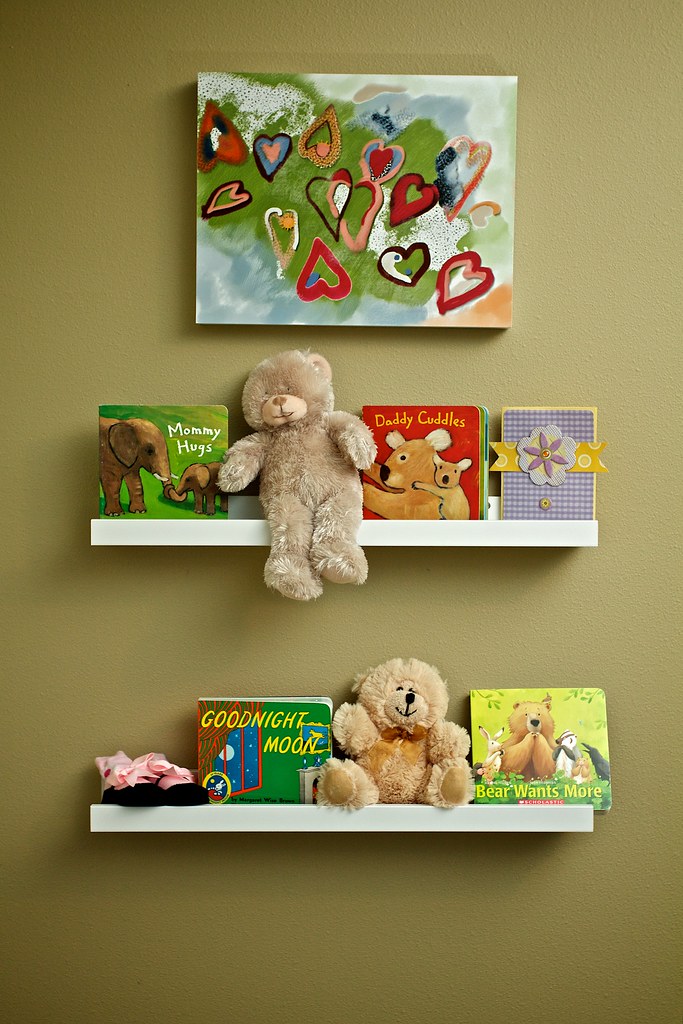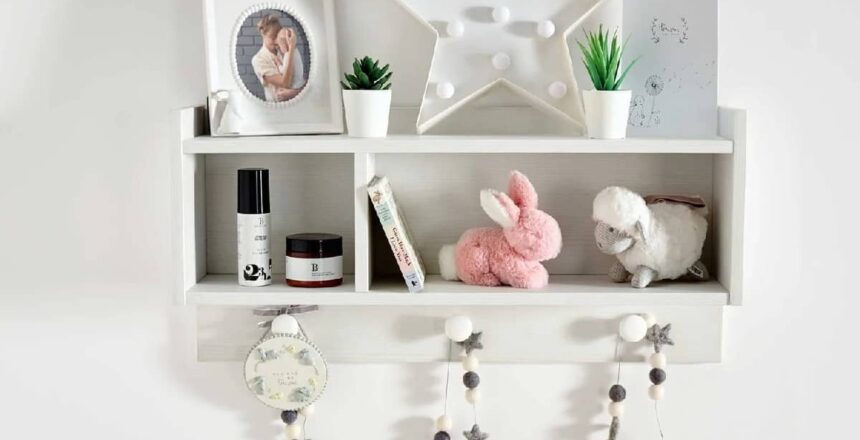Introduction
Imagine this: Your child steps into their nursery and discovers a magical little corner filled with colorful books, cozy cushions, and the promise of endless adventures. It’s not just a shelf with a few storybooks stacked on it—it’s their very own mini library, a space that sparks curiosity and nurtures a love for reading from the very beginning.
But here’s the real secret: Creating that enchanting mini library isn’t as complicated as it sounds. Whether you’ve got a spacious nursery or a cozy little nook, the right nursery book shelf, combined with thoughtful design and a sprinkle of creativity, can transform any space into a storybook wonderland.
In this post, we’ll unlock the secrets to building a nursery book shelf that your child will adore. We’ll cover everything from choosing the right books to creative shelf designs, storage hacks, and tips for making reading an everyday joy. Plus, we’ll highlight why Homey Panda’s nursery book shelf has become a top choice for parents—it’s not just stylish and sturdy, but its mini shelves are perfect for little hands to access their favorite books.
Ready to turn your nursery into a reading haven your child will cherish? Let’s dive into the secrets of creating the perfect mini library!
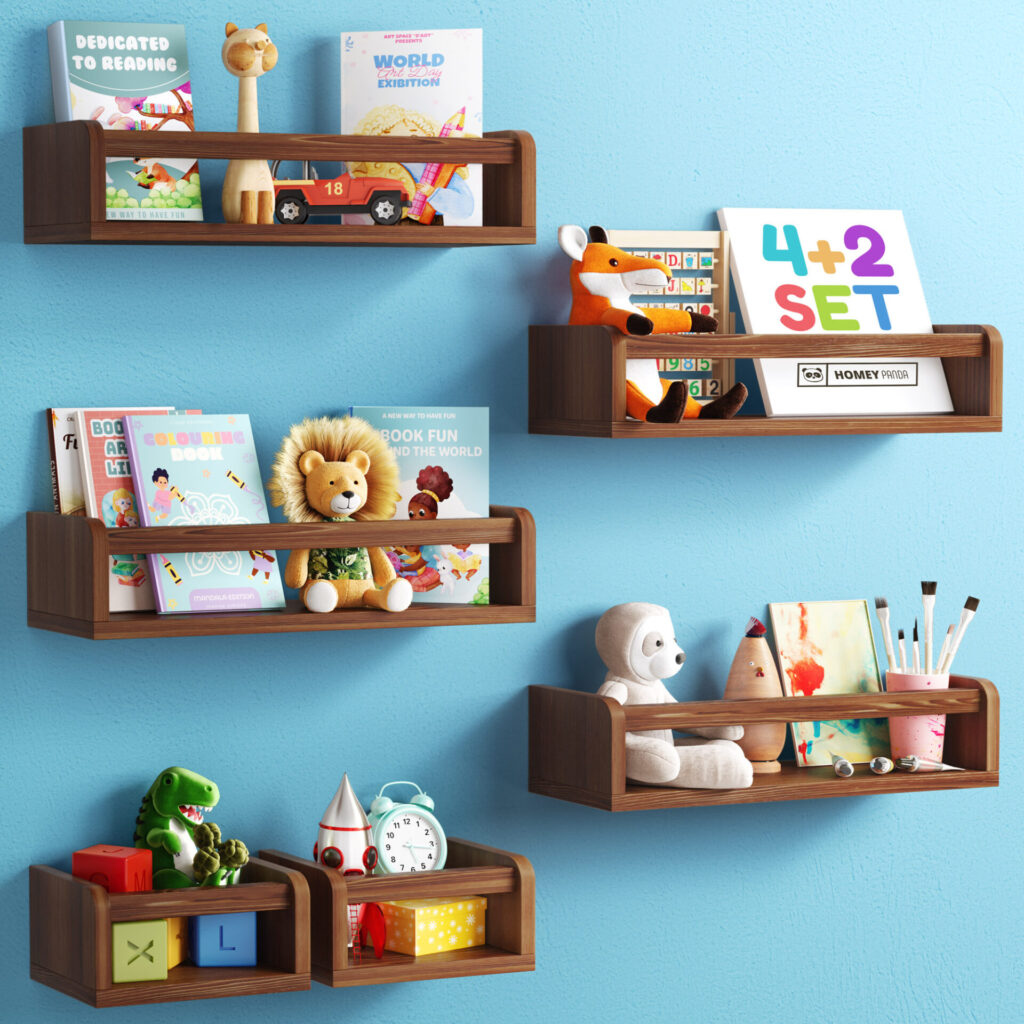
Why Every Nursery Needs a Mini Library
When setting up a nursery, we often focus on essentials like the crib, changing table, and storage for clothes and toys. But there’s one essential that’s just as important for your baby’s development: a nursery book shelf. A mini library in your child’s room isn’t just a cute addition—it plays a powerful role in shaping their early experiences, fostering imagination, and building critical language skills.
Let’s explore why every nursery deserves its own little library.
Fostering Early Literacy and Imagination
Research consistently shows that early exposure to books has a profound impact on a child’s cognitive development. Reading to your baby, even before they can understand words, helps build language skills, develop memory, and stimulate brain growth.
The Power of Early Exposure:
When books are readily accessible on a nursery book shelf, reading becomes a natural part of your child’s day. From the very first board books with simple pictures to more complex stories as they grow, having a dedicated space for books signals that reading is an important and enjoyable activity.
Imagination Takes Flight:
Books are portals to different worlds. Through stories, children meet new characters, explore different cultures, and experience exciting adventures—all from the comfort of their nursery. A cozy mini library fosters this sense of exploration and creativity, helping your child develop not just language skills, but also empathy and critical thinking.
Creating a Safe, Comforting Space for Your Child
A mini library isn’t just about learning—it’s also about creating a cozy, comforting space where your child feels safe and secure. Imagine a quiet corner with soft cushions, a blanket, and a warm reading light. It becomes more than a place for books—it’s a retreat where your child can relax, unwind, and enjoy quality time with you.
The Role of Routine in Building Emotional Security:
Reading together at the same time each day—whether it’s a morning story or part of a bedtime routine—creates a sense of stability and comfort. These small rituals help children feel grounded, and having a dedicated nursery book shelf makes it easy to incorporate reading into daily life.
Why Homey Panda’s Nursery Book Shelf Helps Create a Cozy Space:
The thoughtful design of Homey Panda’s nursery book shelf, with its accessible mini shelves and compact footprint, makes it easy to integrate into any nursery setup. Whether it’s nestled into a corner or displayed prominently as part of a reading nook, the shelf helps create a welcoming space that invites your child to curl up with a favorite book.
Making Books Part of Everyday Life
The beauty of a nursery book shelf is that it makes books a visible and integral part of your child’s world. When books are tucked away in a closet or stored out of reach, it’s easy for them to be forgotten. But when they’re displayed in a fun, inviting way, they become part of your child’s everyday environment.
Integrating Books into Playtime and Daily Activities:
- Playtime: Combine reading with play by pairing books with related toys. For example, after reading a book about animals, bring out stuffed animals or toy figures for your child to play with.
- Bedtime: A nursery book shelf right next to the crib or bed makes it easy to grab a bedtime story, helping to wind down the day with calm, soothing narratives.
- Learning Moments: Use books to explore new concepts or address challenges. Is your child starting potty training? Add some potty-themed books to the shelf. Going on a trip? Add travel-themed stories to prepare them for the adventure.
Encouraging Independence:
When books are stored at your child’s level, they can explore independently. Homey Panda’s nursery book shelf is designed with this in mind—its mini shelves are low enough for little hands to reach, making it easy for toddlers to pick out their favorite stories on their own.
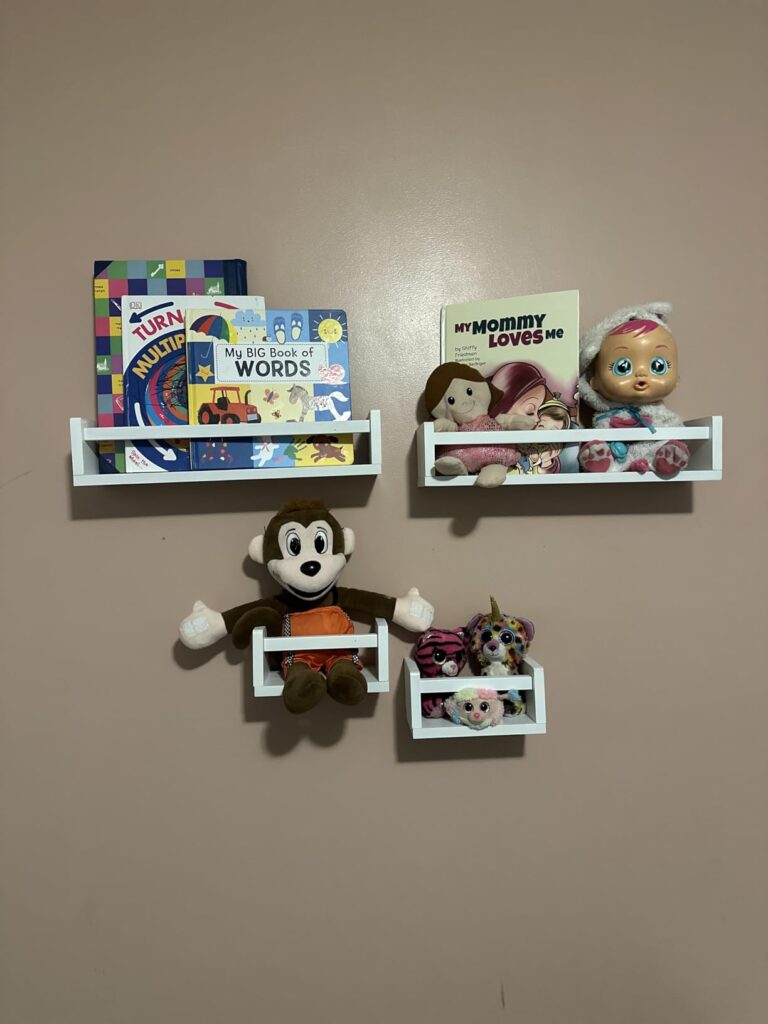
Designing the Perfect Nursery Book Shelf: Layouts and Inspiration
Creating the perfect nursery book shelf goes beyond just finding a spot for your child’s books—it’s about designing a space that sparks curiosity, complements your nursery’s decor, and makes reading irresistible. A well-designed shelf doesn’t just store books; it turns them into a centerpiece of your nursery, inviting your child to dive into new adventures every day.
Let’s explore some creative layouts, clever design ideas, and how to make your nursery book shelf both functional and fabulous.
Think Beyond Traditional Bookshelves: Unique Shelf Designs
When you think of a bookshelf, you might picture a standard rectangular unit with rows of books lined up neatly. But in a nursery, the possibilities are endless. Why not think outside the box and choose a shelf that adds a whimsical touch to the room while keeping things practical?
Floating Shelves:
Floating shelves are a sleek, modern option that’s perfect for nurseries with limited space. They allow you to display books face-out, making them more visually appealing and easier for your child to choose from. Install multiple shelves in a staggered pattern to create a fun, gallery-style look on the wall.
House-Shaped Shelves:
A house-shaped bookshelf adds a playful touch to the nursery while giving the space a cozy, storybook feel. These shelves double as decor and storage, turning your child’s library into an adorable focal point.
Corner Shelves:
If you’re working with a small nursery, corner shelves can help maximize space. They make use of otherwise overlooked areas and can create a snug little reading nook when paired with a comfy chair or cushion.
Why Homey Panda’s Nursery Book Shelf Stands Out:
Homey Panda’s nursery book shelf offers a flexible, modular design with mini shelves that can be customized to fit your space. Whether you want a standalone shelf or a wall-mounted setup, the mini shelves make it easy to create a layout that’s both functional and stylish. Plus, their compact size is perfect for little hands to reach!
Using Wall Space Creatively for a Mini Library Feel
If floor space is limited, don’t worry—your walls can do some heavy lifting! Using vertical space effectively can turn even the smallest nursery into a full-fledged mini library.
Low, Accessible Wall Shelves:
Install wall-mounted shelves at toddler height so your child can easily access their books. This not only encourages independence but also makes the books a visible part of the room’s decor. For extra flair, choose shelves in fun shapes—like clouds, animals, or geometric patterns.
Gallery-Style Displays:
Arrange books like artwork by displaying them face-out on picture ledges or narrow floating shelves. This setup turns the colorful covers into visual focal points and helps create a dynamic, ever-changing display as you rotate books in and out.
Combining Shelves with Reading Nooks:
Create a cozy corner by combining wall shelves with soft seating and warm lighting. A bean bag chair, a fluffy rug, and some string lights can transform a small corner into a magical reading nook your child will love.
Incorporating the Shelf into Nursery Themes
Your nursery book shelf doesn’t have to stand alone—it can be an integral part of your nursery’s overall theme and decor. Whether you’re going for a minimalist aesthetic or a playful, colorful vibe, your shelf can tie the whole room together.
Woodland Themes:
For a woodland-themed nursery, use natural wood shelves and decorate with forest-themed bookends (think owls, foxes, or trees). Add a few nature-inspired books like The Gruffalo or We’re Going on a Bear Hunt to complete the look.
Space Themes:
If your nursery has an out-of-this-world vibe, opt for shelves shaped like rockets or stars. Decorate with glow-in-the-dark elements and space-themed books like There’s No Place Like Space or Astro Girl.
Minimalist Chic:
For a sleek, modern look, choose simple, clean-lined shelves in neutral tones. Arrange books by color or size to create a visually pleasing, organized display that complements the minimalist aesthetic.
Personalizing the Space:
Add your child’s name or initials above the shelf, or include framed quotes from their favorite stories. This personal touch makes the mini library feel like a special, unique part of the nursery.
Adding Decorative Touches to Make the Shelf Pop
Sometimes, it’s the little details that make the biggest difference. Adding a few decorative elements to your nursery book shelf can elevate it from simple storage to a centerpiece of the room.
Themed Bookends:
Bookends aren’t just practical—they’re also an opportunity to add some personality to your shelf. Choose bookends that match your nursery’s theme or let your child pick out their favorites as they grow.
Name Plaques or Custom Artwork:
Incorporate custom name plaques, framed family photos, or artwork to make the shelf feel personal and unique. A simple “Olivia’s Library” sign above the shelf adds a special touch that your child will love as they grow.
Incorporate Fairy Lights or String Lights:
Soft lighting can make your mini library feel magical. Drape fairy lights around the shelf or install a small reading lamp to create a cozy atmosphere for storytime.
Why Homey Panda’s Nursery Book Shelf is Perfect for Decorative Displays:
The modular mini shelves in Homey Panda’s nursery book shelf are ideal for mixing books with decorative items. You can easily create sections for books, toys, and decor, keeping the shelf organized while adding a playful, personalized touch.
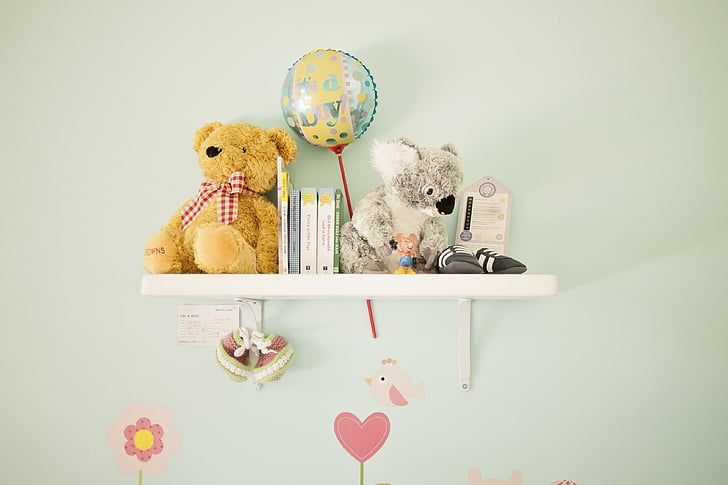
Choosing the Right Books for Your Nursery Library
Designing a beautiful nursery book shelf is just the beginning. To truly build a mini library your child will love, it’s all about the books you choose to fill those shelves. The right mix of stories can spark imagination, foster learning, and even help your little one navigate life’s big emotions.
But how do you choose the perfect books for your nursery library? Let’s dive into selecting age-appropriate, diverse, and engaging reads that will keep your child coming back for more.
Age-Appropriate Book Selection for Every Stage
Books are not one-size-fits-all, especially when it comes to growing children. Choosing age-appropriate books ensures that your child is both entertained and challenged, no matter where they are in their developmental journey.
Board Books for Babies:
For the tiniest readers, board books are the way to go. They’re durable, chew-proof (because let’s be honest, everything ends up in their mouths), and perfect for tiny hands to grip and explore. Look for books with high-contrast images, simple shapes, and basic words. Textured books, like Pat the Bunny or That’s Not My Puppy, add an interactive element that babies love.
Picture Books for Toddlers:
As your child grows, picture books become their window to the world. Bright, engaging illustrations paired with simple but compelling narratives keep toddlers hooked. Classics like Brown Bear, Brown Bear, What Do You See? or Goodnight Moon are always a hit, but don’t shy away from more whimsical stories like The Day the Crayons Quit or Where the Wild Things Are. These books introduce more complex ideas while still being accessible.
Early Readers and Chapter Books for Preschoolers:
By the time your child reaches preschool age, they’re ready for stories with more depth and characters they can relate to. Books like Frog and Toad Are Friends or The Magic Tree House series gently introduce them to longer narratives, preparing them for independent reading down the line.
Pro Tip:
Arrange your books on the shelf by reading level to make it easy for your child to choose the perfect story for their mood. Homey Panda’s nursery book shelf is great for this, as its mini shelves allow you to organize books into different sections based on age or reading level.
Diverse Books that Reflect the World Around Them
Representation matters. It’s essential that your child sees themselves—and others—reflected in the stories they read. Including diverse books in your nursery book shelf helps your child develop empathy, understand different perspectives, and feel a deeper connection to the world around them.
Books Featuring Different Cultures and Backgrounds:
Incorporate stories from various cultures and traditions to expose your child to the rich tapestry of the world. Books like Last Stop on Market Street by Matt de la Peña or Hair Love by Matthew A. Cherry celebrate diversity in everyday life. These stories not only broaden your child’s horizons but also teach them to appreciate the beauty of differences.
Stories with Strong, Varied Characters:
Choose books with protagonists from all walks of life—different races, abilities, family structures, and more. Look for stories like Julian is a Mermaid, which celebrates individuality and self-expression, or All Are Welcome by Alexandra Penfold, which emphasizes inclusivity and community.
Books that Tackle Big Emotions and Life Lessons:
Books are powerful tools for helping children understand and process their emotions. Titles like The Color Monster or When Sadness is at Your Door gently introduce feelings in a way that’s approachable and comforting. These books can be particularly helpful during big transitions, like starting school or welcoming a new sibling.
Balancing Educational and Fun Reads
While educational books are essential, it’s important to strike a balance with stories that are simply fun, silly, and delightful. A well-rounded nursery book shelf includes both types, ensuring that reading feels like a joy, not a chore.
Classic Educational Books:
Books like Chicka Chicka Boom Boom and Dr. Seuss’s ABC make learning letters and numbers an adventure. Similarly, Brown Bear, Brown Bear, What Do You See? teaches colors and animals while maintaining a fun, rhythmic pace that keeps little ones engaged.
Whimsical, Imaginative Stories:
Sometimes, the best books are the ones that make your child giggle. Stories like The Book with No Pictures by B.J. Novak or Don’t Let the Pigeon Drive the Bus! by Mo Willems embrace silliness in a way that captivates young readers. These books show that reading isn’t just educational—it’s also fun.
Mixing the Two:
Look for books that combine learning with humor or creativity. Ada Twist, Scientist and Rosie Revere, Engineer introduce STEM concepts through engaging stories and relatable characters. This blend of fun and education keeps children curious and eager to learn more.
Building a Library That Grows with Your Child
A great nursery library isn’t static—it evolves as your child grows and their interests change. Planning for this growth ensures that your nursery book shelf remains a beloved part of their room for years to come.
Start Small, Build Over Time:
You don’t need to fill the shelves all at once. Begin with a handful of beloved classics and add to the collection as your child’s interests and reading abilities develop. Rotate in new books regularly to keep things fresh.
Involve Your Child in the Selection Process:
As your child gets older, let them help choose new books for their library. Whether it’s a trip to the bookstore, a visit to the library, or an online shopping spree, involving them in the process gives them a sense of ownership and excitement about their collection.
Pro Tip:
Use Homey Panda’s nursery book shelf to create distinct sections for different stages of reading. As your child’s collection grows, you can easily adjust the display to highlight their current favorites while keeping older treasures close at hand.
Creative Storage and Display Ideas to Make Books Irresistible
So, you’ve curated the perfect collection of books for your nursery book shelf. Now comes the fun part—displaying them in a way that makes your little one want to reach for them every day. The way you organize and present books can be just as important as the stories themselves. After all, a beautifully arranged shelf doesn’t just keep things tidy; it invites curiosity, fosters independence, and turns reading into an exciting adventure.
Let’s dive into some creative, practical, and fun storage and display ideas that will make your nursery library the heart of the room.
Front-Facing Displays to Showcase Covers
One of the simplest ways to make books more appealing to young readers is to display them face-out. Unlike adults, who gravitate toward titles and authors on spines, kids are drawn to bright, colorful covers that catch their eye and spark their imagination.
Why Seeing the Covers Matters:
When children can see the front of the book, it immediately becomes more inviting. The illustrations, characters, and vibrant colors call out to them, making it easier to choose a story independently. This also encourages them to explore new books they might otherwise overlook.
Creating a Book Gallery:
Think of your nursery book shelf as an art gallery. Rotate the books regularly to keep the display fresh and exciting. You can even group books by color, theme, or season to create visually stunning arrangements that double as decor.
Why Homey Panda’s Nursery Book Shelf Is Perfect for Front-Facing Displays:
Homey Panda’s nursery book shelf is designed with mini shelves that are just the right size for displaying books face-out. The compartments are perfectly spaced for showcasing your child’s favorites while keeping the shelf organized and clutter-free. Plus, the accessible design means your little one can easily grab books on their own, fostering independence from an early age.
Themed Book Rotations to Keep Things Fresh
Even the most beloved books can lose their magic if they’re always on display. Rotating your child’s books based on themes, seasons, or interests keeps the shelf dynamic and engaging. It’s like giving your library a mini makeover every month!
Seasonal and Holiday Rotations:
Rotate books to reflect the time of year. In the fall, bring out stories about pumpkins, leaves, and Halloween, like Room on the Broom or The Little Scarecrow Boy. In winter, swap them for cozy tales like The Snowy Day or Bear Stays Up for Christmas. This keeps your child excited about their collection and helps them connect stories to the world around them.
Weekly Themes to Match Interests:
Does your child have a current obsession with dinosaurs, trucks, or space? Create a themed display to match their interests. One week, it’s all about animals; the next, it’s bedtime stories. This makes the nursery book shelf feel new and exciting without constantly buying new books.
Creating a “Book of the Week” Feature:
Dedicate a special spot on the shelf for a Book of the Week. Let your child choose their favorite story to showcase front and center. This simple ritual makes reading feel special and gives your child a sense of ownership over their library.
Combining Books with Toys and Décor for a Playful Look
Your nursery book shelf doesn’t have to be just for books. Blending books with toys, art, and decor turns the shelf into a playful, inviting space that feels like part of your child’s world.
Pairing Books with Related Toys:
Pair books with related toys to create interactive displays. For example, place a plush bear next to Brown Bear, Brown Bear, What Do You See? or a toy rocket next to There’s No Place Like Space. This makes the shelf more engaging and encourages your child to connect stories with playtime.
Incorporating Decorative Elements:
Add framed art, name plaques, or small figurines to personalize the shelf. A framed quote from a favorite story, like “Oh, the places you’ll go!”, adds a meaningful touch. You can also use themed bookends—like animals, stars, or vehicles—to keep books upright while adding a decorative flair.
Using Baskets and Bins for a Tidy Look:
Use small baskets or bins to organize smaller books, art supplies, or toys. This keeps the shelf looking neat while ensuring everything is easily accessible. Fabric bins in fun patterns or colors can add a pop of personality to the shelf.
How Homey Panda’s Nursery Book Shelf Makes It Easy:
With its thoughtfully designed mini shelves, Homey Panda’s nursery book shelf makes it easy to mix books with decorative items. The compartments naturally separate books from toys and decor, keeping everything organized without sacrificing style. Plus, its sturdy design ensures that even the most playful setups stay secure.
Maximizing Small Spaces: Smart Storage Hacks
Not every nursery has room for a large bookshelf, but that doesn’t mean you can’t create a beautiful, functional mini library. With a few clever storage hacks, you can make the most of even the smallest spaces.
Over-the-Door Book Storage:
Use over-the-door organizers with clear pockets to store books in a compact, accessible way. This is especially handy for board books and smaller stories. Plus, it frees up floor space while keeping books within easy reach.
Under-Bed Storage for Extra Books:
If your child’s book collection is growing faster than your shelf space, use under-bed storage bins to keep extra books organized. Rotate them onto the shelf as needed to keep the display fresh without overcrowding.
Utilizing Wall Space:
Don’t forget about vertical storage! Wall-mounted shelves or picture ledges can turn an empty wall into a mini library. Arrange the shelves at different heights to create a dynamic, eye-catching display that doubles as wall art.
Corner Shelves and Nooks:
Make use of awkward corners by installing corner shelves or creating a cozy reading nook. Add a small chair, a cushion, and some fairy lights to transform even the tiniest corner into a magical reading space.
Final Thought: Make the Shelf as Fun as the Stories
The secret to a nursery book shelf your child will love isn’t just in the books themselves—it’s in how you present them. By creating an inviting, playful space that feels like an extension of your child’s world, you make reading irresistible. Whether it’s through colorful displays, themed rotations, or interactive setups that blend books with toys, the way you organize your shelf can transform it into the heart of your nursery.
And with Homey Panda’s nursery book shelf, turning your nursery into a storybook wonderland has never been easier. Its mini shelves are perfect for creative displays, making it simple to keep things organized while sparking your child’s curiosity and love for reading.
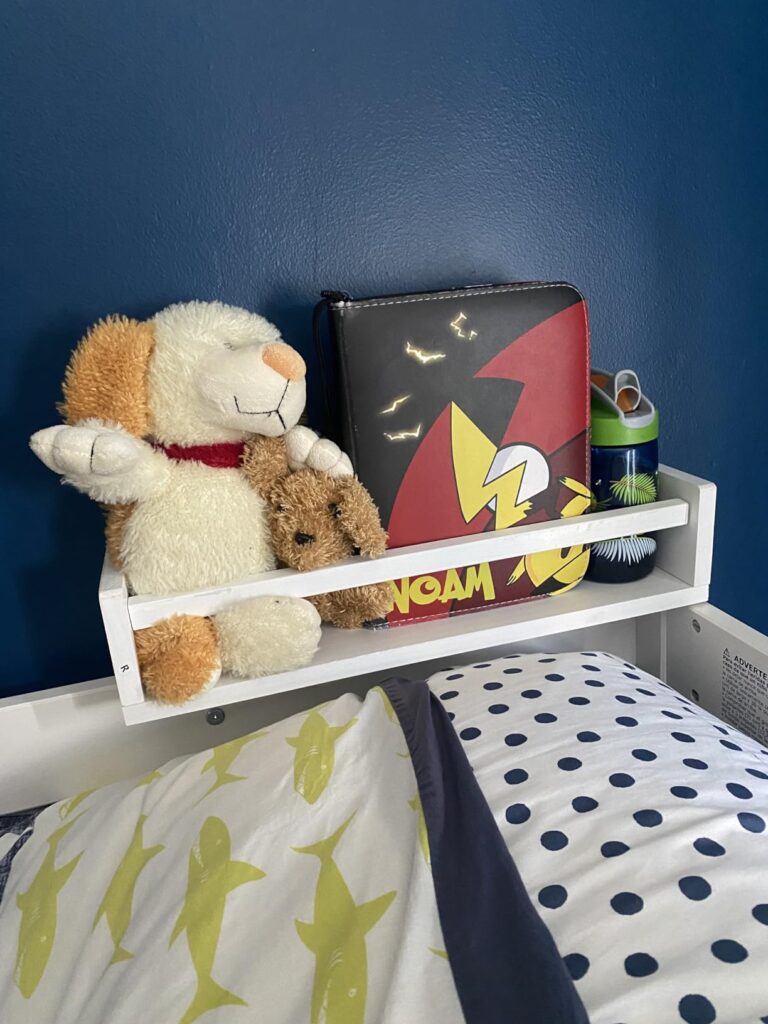
Making Reading a Daily Habit: How to Encourage a Love of Books
Creating a nursery book shelf that’s beautifully styled and well-stocked is just the beginning. The real magic happens when books become part of your child’s daily life. Building reading into your everyday routine helps foster a love of stories, encourages independent exploration, and sets the foundation for lifelong learning.
But how do you turn books from something that’s there into something that’s loved? Let’s dive into fun, practical strategies to make reading a cherished part of your child’s day.
Building Reading into Your Daily Routine
Consistency is key when it comes to developing a reading habit. By incorporating books into your daily routine, you help normalize reading as a fun and regular activity—not just something reserved for bedtime.
Morning Storytime:
Who says bedtime gets to have all the reading fun? Start the day with a short, cheerful story to set a positive tone. Choose books that are light, fun, and energizing—think Pete the Cat or The Very Hungry Caterpillar. This not only sparks early morning curiosity but also sets a calm, happy mood for the day ahead.
Quiet Time Reading in the Afternoon:
After lunch or during a mid-afternoon lull, create a quiet time routine with books. Even if your child isn’t ready for a nap, a calm story can provide a much-needed break in the day. Keep a few soothing stories, like Goodnight Moon or Guess How Much I Love You, on your nursery book shelf for these moments.
Bedtime Rituals:
Bedtime and books go hand-in-hand. Make reading the final, comforting activity of the day. Let your child choose their favorite story from the shelf, snuggle up together, and wind down with familiar tales or gentle new ones. The routine of picking a book from the same shelf each night helps reinforce the connection between reading and relaxation.
Pro Tip:
Use Homey Panda’s nursery book shelf to create separate sections for different times of the day. For example, dedicate one mini shelf for bedtime books and another for morning or afternoon reads. This makes it easy for your child to pick the right book for the right time.
Interactive Storytime Techniques
Reading doesn’t have to be a passive activity. By making storytime interactive, you engage your child’s imagination, encourage participation, and make books even more exciting.
Use Voices and Sound Effects:
Give each character a unique voice or add fun sound effects to bring the story to life. Whether it’s a deep, growly voice for a bear or a high-pitched squeak for a mouse, these little touches make the story more engaging and memorable.
Ask Questions and Encourage Predictions:
Pause during the story to ask questions like, “What do you think will happen next?” or “How do you think the character feels?” This not only keeps your child engaged but also helps develop critical thinking and comprehension skills.
Let Your Child Turn the Pages:
Even if they’re too young to read, letting your child turn the pages makes them feel involved. It gives them a sense of control and makes reading feel like a shared activity rather than something they’re just observing.
Incorporate Props or Toys:
Bring stories to life by using toys or props. Reading Brown Bear, Brown Bear? Gather some animal figurines to match the characters. For We’re Going on a Bear Hunt, create a mini obstacle course to mimic the story’s journey. These hands-on activities help your child connect more deeply with the story.
Creating a Reward System for Reading
While reading should be fun for its own sake, a little extra motivation never hurts—especially when you’re trying to build a new habit. Creating a reward system makes reading feel like an exciting challenge and gives your child something to look forward to.
Sticker Charts and Reading Milestones:
Set up a sticker chart where your child earns a sticker for each book they read (or listen to). After collecting a certain number of stickers, they can choose a new book, a small toy, or a special activity as a reward. This helps reinforce the habit while making it fun and goal-oriented.
Hosting “Reading Picnics” or Special Storytime Events:
Turn reading into an event by hosting a “reading picnic” in the living room or backyard. Pack a blanket, some snacks, and a few favorite books from the shelf for a fun, memorable reading session. You can also create themed storytimes based on holidays, seasons, or your child’s current interests.
Bookstore or Library Visits as Rewards:
Use trips to the bookstore or library as a reward for consistent reading. Let your child pick out a new book for their nursery book shelf, giving them a sense of ownership over their growing collection.
Encouraging Independent Reading and Exploration
While shared reading is essential, it’s equally important to encourage your child to explore books on their own. Fostering independence helps build confidence and nurtures a personal connection to reading.
Keep Books Accessible:
Ensure that books are stored at your child’s level so they can easily grab them whenever inspiration strikes. Homey Panda’s nursery book shelf is designed with mini shelves that are perfectly sized for little hands, making it easy for toddlers to explore books independently.
Create a Cozy, Inviting Reading Space:
Make reading irresistible by setting up a cozy nook with soft cushions, blankets, and warm lighting. A comfortable, inviting space encourages your child to curl up with a book and lose themselves in a story.
Let Your Child Choose Their Own Books:
Give your child the freedom to choose which books they want to read, even if it means reading the same story for the hundredth time. This autonomy fosters a sense of ownership and makes reading feel like a personal, enjoyable activity.
Making Reading Social: Involve Family and Friends
Reading doesn’t have to be a solo activity. By involving family and friends, you turn books into a shared experience that strengthens bonds and makes reading even more enjoyable.
Family Storytime:
Make reading a family affair by setting aside time for everyone to gather and share stories. Rotate who picks the book each night or take turns reading different parts of the story. This not only makes reading fun but also creates lasting family memories.
Virtual Storytime with Distant Family Members:
If grandparents or other relatives live far away, set up virtual storytime sessions over video calls. This helps maintain family connections and makes reading feel like a special, shared event.
Book Swaps with Friends:
Organize book swaps with other parents or friends. This introduces new stories to your child’s collection and adds an element of excitement as they discover books their friends love.
Final Thought: Make Reading the Best Part of the Day
The goal of building a nursery book shelf isn’t just to have a tidy, organized space—it’s to create an environment where books are loved, cherished, and part of everyday life. By incorporating reading into your daily routine, making storytime interactive, and encouraging independent exploration, you’re setting the stage for a lifelong love of books.
And with Homey Panda’s nursery book shelf, creating that magical, inviting space is easier than ever. Its thoughtfully designed mini shelves make it simple to keep books organized and accessible, turning your nursery into a storybook wonderland your child will treasure.
Organizing for Growth: How to Expand Your Mini Library Over Time
As your child grows, so will their love for books—and their nursery book shelf needs to keep up! A flexible, well-organized shelf not only keeps things tidy but also encourages your child to explore new stories and develop their reading skills.
Planning for a Growing Collection Without Overcrowding
It’s easy for a nursery book shelf to become cluttered as new books pile up. The key is to plan for growth from the start.
- Use Modular or Adjustable Shelves: Opt for shelves that can adapt over time, like Homey Panda’s nursery book shelf, which features mini compartments that can be rearranged as your collection expands.
- Rotate Books Regularly: Keep the shelf fresh by rotating books in and out. Store extras in a bin or closet, and swap them seasonally to maintain interest.
- Declutter Periodically: Donate or store books your child has outgrown to make room for new favorites.
Involving Your Child in Curating the Library
Empowering your child to take part in organizing their nursery book shelf fosters responsibility and a deeper connection to their books.
- Let Them Choose New Books: Take your child to the bookstore or library and let them pick stories that excite them.
- Create Special “Favorite” Sections: Dedicate a shelf to your child’s current favorites, allowing them to update it as their tastes evolve.
- Teach the Joy of Sharing: Encourage your child to donate books they’ve outgrown to friends, family, or local charities.
Seasonal Decluttering and Refreshing the Shelf Display
A clutter-free shelf keeps things inviting. Refreshing your display regularly helps maintain excitement.
- Seasonal Themes: Swap books based on holidays or seasons. For example, winter-themed stories in December or beach books in summer.
- Add Decorative Touches: Update the shelf with seasonal decorations, like mini pumpkins in fall or fairy lights in winter.
- Reorganize for Fun: Occasionally change the layout—by color, size, or theme—to give the shelf a new look and feel.
Safety and Practical Considerations for Your Nursery Book Shelf
Safety is key when creating a nursery library, especially as your child becomes more independent.
- Choose Kid-Friendly Materials: Look for non-toxic finishes, smooth edges, and sturdy designs like Homey Panda’s nursery book shelf, known for its child-safe construction.
- Anchor Shelves Securely: Always anchor freestanding or wall-mounted shelves to prevent tipping.
- Organize with Safety in Mind: Place heavier books on lower shelves, and keep small decorative items out of reach.
Final Touches: Personalizing Your Nursery Book Shelf
A personalized library makes reading even more special.
- DIY Projects: Let your child decorate bookends or paint the shelf for a personal touch.
- Create a Cozy Reading Nook: Add cushions, a soft rug, and warm lighting to make storytime inviting.
- Capture Reading Milestones: Document your child’s favorite books and reading milestones in a journal or photo album.
Conclusion: Unlocking the Magic of Your Nursery Mini Library
A thoughtfully designed nursery book shelf is more than just storage—it’s a gateway to adventure, learning, and lifelong memories. By choosing the right books, creating an inviting space, and making reading a daily habit, you’re giving your child the gift of a lifelong love for stories.
And with Homey Panda’s nursery book shelf, you get the perfect blend of style, safety, and functionality. Its mini shelves are ideal for little hands, making it a favorite among parents looking to build a magical, functional mini library.
Call-to-Action
Ready to create a storybook wonderland in your nursery? Share your nursery book shelf setups in the comments and explore more creative nursery organization ideas on our blog. Don’t forget to subscribe for more tips on turning your child’s room into a space they’ll love! 📚✨
